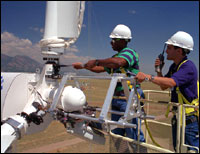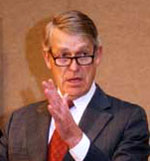Two ambitious clean-energy coalitions made headlines this month, sweeping out from under the rug vital and far-reaching environmental issues that the Bush administration has steadfastly ignored. The Energy Future Coalition, boasting endorsements from heavies on both sides of the party line as well as from high-profile industry and environmental interests, called for a one-third reduction in U.S. oil consumption and a one-third reduction in carbon dioxide emissions over the next 25 years. At the same time (though in a completely unrelated effort), the Apollo Alliance, a labor-environmental coalition endorsed by a dozen influential unions, called for a 10-year, $300 billion federal investment in clean-energy technologies and green building, which would lead to the creation of more than 1 million new manufacturing jobs designed to help usher in a sustainable economy.

A win-wind situation: jobs
servicing turbines.
Photo: NREL.
Both the Energy Future Coalition and the Apollo Alliance presented useful energy-policy recommendations to achieve their goals, but a larger, more valuable lesson lies in the strategy these groups deployed to get their messages out to the public. At a time when environmental issues are barely registering as a tremor on the Richter scale of public concerns — compared, say, to the seismic quakes of war, recession, and the general Mad Cowboy Disease reverberating throughout America’s domestic and foreign policy — green crusaders are faced with the challenge of how to make environmental concerns matter to both voters and candidates in the 2004 election. The Energy Future Coalition and the Apollo Alliance have hit on an effective approach that the movement as a whole would do well to adopt: Wrap an environmental agenda in the mantle of today’s more emotionally immediate issues of national security and new jobs.
Take, for instance, the motto that the Apollo Alliance uses in its promotional material: “Let’s switch our energy dependence from the Middle East to the Midwest: Freedom from Mid-East oil. One million new energy jobs.” Not a word is mentioned about the environment, even though the alliance calls for aggressive federal incentives for hybrid-electric cars, green buildings, solar panels, wind turbines, energy-efficient appliances, carbon-scrubbers on power plants, improved public transportation, a high-efficiency magnetic-levitation rail system, smart urban growth, and other cutting-edge green innovations that, if encouraged on a federal level, would create huge opportunities for job growth and be a major boon to the environment.
The failure to express this initiative in green terms was hardly an oversight, according to Apollo Alliance President Bracken Hendricks, who has been gathering support for the alliance over the past year and first publicly announced its existence on June 5. “Though we are trying to achieve objectives that will bring enormous gains to the environment, they will also bring major security and economic-development benefits, and that’s what concerns people today and that’s what catches their attention,” he says.

Sunny prospects: workers in a
photovoltaic plant.
Photo: NREL.
When defining its strategy and mission, the Apollo Alliance conducted a poll in Pennsylvania, a key industrial swing state, where it asked voters, “What’s the most important issue right now?” Seventy-two percent of respondents cited economic distress and loss of manufacturing jobs, while 2 percent cited the environment. But when the same voters were asked whether they would support a plan that would aggressively develop a green economy and be an engine for 1 to 3 million new manufacturing jobs, 72 percent said they would strongly support it.
“The environmental movement needs to recognize a unique moment right now in the political climate when there are pressing challenges for progressives: the hollowing out of the manufacturing job space and the national security imperatives around imported oil,” says Hendricks, who worked on sustainable development issues for Vice President Al Gore during the Clinton administration. “We can answer these challenges directly while channeling our solutions toward green outcomes.”
The power of Hendricks’ argument is evident in the growing roster of unions that have signed on to the Apollo Alliance — the United Steelworkers of America, the International Association of Machinists and Aerospace Workers, the United Mine Workers of America, and the International Brotherhood of Electrical Workers among them. That power is particularly potent when you consider that most of these unions each have well over half a million members and represent a critical segment of America’s voter base.
Futurama

Timothy Wirth hatches
a plan.
Photo: U.N.
Like the Apollo Alliance, the Energy Future Coalition deftly couched its proposals in the hot-button issues of today’s political climate. The idea for the Energy Future Coalition was hatched soon after the events of Sept. 11, 2001, by Timothy Wirth, former Democratic senator from Colorado and president of the United Nations Foundation, and some colleagues over a dinner discussion about the vast implications of the tragedy and the related energy issues. They gathered support from a long list of notables; members of their advisory board and steering committee include R. James Woolsey, former CIA director, Roxanne J. Decyk, senior vice president of Shell Oil, Chansoo Joung, managing director of Goldman Sachs, Howard (Bud) Ris, president of the Union of Concerned Scientists, and Maggie Fox, deputy executive director of the Sierra Club.
Over the last 18 months, the coalition convened six working groups in the areas of transportation, biofuels and agriculture, energy efficiency, international energy issues, the future of coal, and a “smart” electricity grid (one designed for efficiency and compatible with all forms of distributed generation). In each area, representatives from business, labor, and environmental groups weighed in on how they proposed to achieve dramatic reductions in oil use and carbon dioxide emissions by 2030, and the results have been published in a 129-page report. Though the report does cite global warming as one of its central concerns, the language of the report focuses heavily on the economic opportunity of innovation, national security, and America’s leadership role and reputation after invading Iraq.
“The world is watching to see what next step we take and whether America’s can-do attitude will chart a new course for everyone. This is a time of opportunity — a major technological revolution is beginning in energy, with great potential markets. And the reality is that where America goes, others will likely follow,” says the report’s introduction. “America’s example sets the tempo and the direction of action far beyond its borders and far into the future.”

Reid Detchon looks on
the bright side.
Photo: NEP Initiative.
This apparent opportunism might be somewhat disturbing for those of us who had objections to the war on Iraq, but it may also be a sound strategy, given the daunting challenge in today’s climate of making radically eco-friendly proposals sound not only feasible but appealing to corporate titans and Beltway decision-makers. “We went to great lengths to make the tone of our proposal positive and optimistic,” said Reid Detchon, executive director of the Energy Future Coalition, who pointed out that the energy debate has historically been defined by warring special interests — that is, by an intractable stalemate between environmentalists and industry. “This conflict, along with overwhelming issues like global warming and energy independence, inspires a feeling of hopelessness and futility, and then gets tossed into the too-hard category, which is why it’s so critical [for clean-energy advocates] to maintain a tone of optimism,” he said.
One of the key conservative leaders of the coalition, C. Boyden Gray, who was former legal counsel to George Bush Sr. and is an unapologetic skeptic of climate science, exhibited a bit more gravitas when describing his involvement at a coalition press conference: “Our economy and living standards are still hostage to forces beyond our control. Every recession in the last 40 years was preceded by a significant increase in oil prices. And as we all know too well, supply disruptions and price shocks are not the only risks of our oil dependence. I am heartened that leaders from the automobile industry, labor, and environmental groups all agree on the need to promote advanced vehicles and cleaner, alternative fuels.”
It was clear that Gray and the other coalition leaders — Timothy Wirth and John Podesta, formerly President Clinton’s chief of staff — agreed that their common interest lay in signaling to Washington not only that all these hot-button issues are interconnected, but also that the environment-industry impasse is not insurmountable. “If the political establishment looks up and says, ‘We can move beyond the current inertia in the system,’ they’d find a very broad coalition,” says Podesta.
To date, though, the Bush administration has summarily dismissed any attempts at bridging the differences among business, labor, and environmental groups. “The administration made a decision in early 2001 that they were not going to waste any time with all this silly dialogue stuff that has for decades led to stalemate; they were just going to talk to their friends in business and just go ahead and get the job done [without any bickering],” says David Hawkins, director of the Climate Center at the Natural Resources Defense Council and the cochair of the EFC’s coal working group. The current conversation sparked by these two coalitions — a conversation taking place on such a grand scale and with so many notable public figures from different sides of the debate — makes the administration’s attitude seem all the more myopic.
Winners and … Winners?
As it turns out, the strategy of cooperation was in itself enough to get the message out. In the Wall Street Journal, the New York Times, the Washington Post — everywhere, the coverage of the Energy Future Coalition and the Apollo Alliance played up the “adversaries unite!” angle.
But exactly how extensive is the agreement between these historically conflicting interests? Are we really talking about that proverbial win-win-win situation here? How much does the environmental movement stand to gain by hitching its wagon to the stars of these other, more emotionally immediate issues?

Farmers are
harvesting a new crop
— wind power.
Photo: NREL.
There’s no question that the call for energy independence on the heels of the terrorist attacks of Sept. 11, 2001, has brought tremendously valuable attention to energy issues, including alternative and renewable energy and global climate change. “If you play a word-association game with the average person with terms like ‘energy independence, oil, and global warming,’ it wouldn’t take long for all these topics to get listed,” said NRDC’s Hawkins. “So from a public-education standpoint, it’s very effective to connect the dots between these topics.”
There’s also no question that linking the environment to the debate over economic growth is very effective. “Smart industry understands that environmental strategies are beneficial, long-term, for their bottom line. The corporate world responds when environmentalists point out that America’s failure to develop efficient, high-performance technologies [such as hybrid cars and renewables] will undermine its competitive advantage in the global marketplace,” said Thomas Lovejoy, president of the H. John Heinz III Center for Science, Economics, and the Environment and a member of the EFC steering committee.
There is, however, one critical issue to which the corporate world does not respond positively: regulation. Neither the Apollo Alliance nor the Energy Future Coalition could get their corporate or union members to agree on the need for regulations such as mandatory caps on carbon dioxide emissions or fuel-efficiency standards. “Both sides were in favor of increased federal-level subsidies and tax incentives for everything from biomass and fuel cells to carbon sequestration technologies,” said Hawkins. “But, as you might expect, most industry interests were simply not ready to endorse policies to limit carbon emissions, even after nine months of negotiations.”
Similarly, most unions immediately shy away from discussions about Corporate Average Fuel Economy standards. “Regulations like CAFE can have the unintended consequence of resulting in job loss. If regulations are poorly structured, they can increase the amount of outsourcing companies do, increase the amount of foreign transplants, and increase the overall level of imports. Unions are very sensitive to that,” said Hendricks. “We focused our discussions on how policies can be used to drive new investment domestically. Standards can be part of the equation, but our commitment is to preserving good jobs and the environment together.”
Nice Work if You Can Get It
Yielding on the issue of regulations is hardly a small concession for environmentalists, however important it might be to piggyback on economic growth and national security. And yet we should not underestimate the promise of the economic-growth argument, especially when looking at how to make environmental issues matter in the next two years.
If you believe, as alternative-energy enthusiasts do, that the clean-energy world is very much like the information-technology world of a decade ago — that is, if you believe that it is poised for colossal growth — then the job-creation promise is no pipe dream. Unlike the dot-com “revolution,” which was based on dubious business models for unproven markets and untried technologies, clean-energy proponents are talking about established markets for life’s essentials: lights, refrigerators, cars, televisions, air conditioners. Meeting those needs in the coming years means huge capital investments in manufacturing, and that means job growth.

Another bright day in the
solar biz.
Photo: NREL.
“Increased investment in clean energy and green building means turning over capital stock — replacing things like fan motors, lighting ballasts, heating and air conditioning systems, boilers and chillers, the capital stock of the built environment — which means new construction jobs and new manufacturing of durable goods,” says Hendricks. The job-growth potential is even more dramatic when you factor in wiring a massive “smart” electricity grid; manufacturing solar panels, wind turbines, and super-efficient natural gas turbines; and eventually laying the pipes for a nationwide hydrogen-distribution system.
Tom Buffenbarger, president of the International Association of Machinists and Aerospace Workers, a 730,000-member union that is actively involved in the Apollo Alliance, heartily agrees: “Our machinists are well aware that the clean-energy movement spells the promise of new jobs. Top-level executives might be wary of the front-end investments in this kind of shift, but our union members have a much longer view about their careers. Our goal is not a quarterly report; what we worry about is raising our families and the long-term security of our jobs and our nation.”
Indeed, the job-creation argument is so persuasive, and the response from the unions has been so positive, that Democratic presidential contenders are beginning to add the principles behind the Apollo Alliance to their platforms. While all the leading Democratic candidates have expressed support for innovations in clean and efficient energy technologies, and see them as a source of economic stimulus, both Sen. John Kerry (Mass.) and Rep. Dick Gephardt (Mo.) have released the most definitive alternative-energy proposals, going so far as to say that the power shift will be the single biggest source of job creation in the next century.
But where, one might ask, will we get all the federal funds to spur this investment along? Hendricks has the answer: “If you contrast the long-term job creation of tax cuts to federal investments in infrastructure and industry, you see that an investment-led strategy achieves at least five times the number of jobs per dollar, based on what the Bush administration thinks the economic stimulus will be from their tax cut.” According to the Apollo Alliance poll conducted in Pennsylvania, 72 percent of all respondents (Democrat and Republican alike) not only supported a $300 billion federal investment in the clean-energy sector, but favored that plan over tax cuts.
“We need to jam these poll results and the principles of the Apollo Alliance down the throat of every presidential candidate,” said Leo Gerard, president of the United Steelworkers of America, a 670,000-member union. “The environmental movement can’t win on its own in the coming election, and the labor movement can’t win on its own, but if we band together we’ll have a fighting chance.”
Indeed, in the effort to make environmental issues matter — to Washington decision-makers and voters alike — virtually no signal is stronger than a powerful blue-green alliance. Detchon, executive director of the Energy Future Coalition, said that the involvement of labor unions was among the most significant steps forward in their negotiations: “I was particularly pleased by the willingness of labor unions to participate, because until now they really haven’t played much of a part in energy debates. They bring a powerful voice of pragmatism to the issues.” In short, while unions bring to the corporate argument a much-needed longer-term perspective, they bring to the environmental side just the opposite — a more immediate awareness that this debate can’t be only about ideology, ideals, and abstract results, but must also be about forging an economically realistic plan of action.
